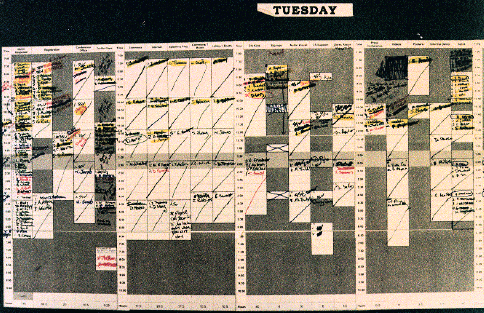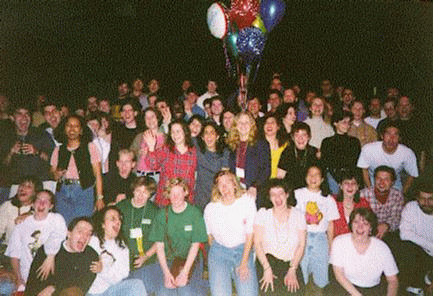Issue
Article
Vol.28 No.4, October 1996
Article
Issue
Issue |
Article |
Vol.28 No.4, October 1996 |
Article |
Issue |

A Hard Day's Work: Part of the SV Worksheet for Tuesday
The Students Column in the October 1995 issue of the SIGCHI Bulletin detailed the purpose, duties and importance of Student Volunteers (SVs) at the CHI conference. The aim of this article is to talk about the benefits of being an SV in more detail. In particular, the advantages of meeting a large variety of people and potential co-workers are outlined. Networking opportunities are vast and this is discussed from two perspectives. Firstly from the point of view of a "newbie" to CHI (the first author) and secondly from a "veteran" SVs angle (the second author). The aim is to encourage the CHI community to continue taking an interest in the academic lives of SVs. Also, the article serves to highlight the rewarding time had by SVs and attempts to persuade other students in the SIGCHI community to volunteer their services!
The first people seen by SVs at CHI are other SVs. This enables friendships to be made swiftly and is an overall exciting and rewarding experience. The usual questions ensue concerning one's country of study and academic interests. This was particularly true of SVs who turned up for "bag stuffing"; the task was to fill the conference canvas bags in conjunction with the rapid name learning (and forgetting!) of other SVs.
The development of cohorts of SVs was prevalent although the construction of each group was varied. For example some students were grouped together by their department or institution. Others found that they had common interests with other SVs and rapidly formed small research groups that arguably constitute microcosms of the CHI community. This provided a forum where students could bounce ideas off each other concerning their particular area of research. It provided the opportunity for gaining some constructive criticism in an informal atmosphere. Students were also able to exchange references and important sources of information. Of great advantage was the chance to exchange contact addresses with other SVs working in the same area. The experience of being an SV is thus an invaluable way of making contacts with other students involved in similar research that you may not have otherwise met.
Meeting other SVs was not merely beneficial for research purposes; lots of fun was had too! For most, the event was an opportunity to experience the delights of a wonderful city away from their own country, whilst resident SVs were given the chance to show off the sites of their home ground. Many SVs met whilst staying in the same hotel which enabled everybody to unwind after a hard day's work. Similarly, the SV lounge after work hours became an area of relaxation, copious eating and fun.
Students were able to interact with many academics that are active in the CHI community. There were numerous chances for this to happen. Firstly, SVs were able to chat to speakers when providing either session or tutorial support. This was organised in a manner whereby SVs could chose to work particular sessions that they were interested in attending. This resulted in many SVs getting to know people that had great involvement in their field of interest and hence the chance to form new research collaborations. SVs get to attend the conference sessions and panels as `payment' for their hard work. This provides another invaluable opportunity for SVs to chat to speakers and other researchers. Another reward of being an SV is that delicious hotel food is provided daily in the SV lounge. Each day, several guests were invited to dine with the SVs in the lounge. This was an excellent opportunity to chat to important members of the CHI community in an informal manner. Meeting academics who have written books and papers read by students can be extremely rewarding. More importantly, the authors were extremely approachable and hence SVs had no need to hesitate in discussing their work with them. These lunches also facilitated the exchange of contact addresses.
Another satisfying aspect of attending CHI is gaining confidence about one's work, particularly for research students at the early stages of their research. By mixing with many people with the same interests it is possible to gain reassurance that one's research is both interesting and purposeful. This in turn can lead to increased enthusiasm for the academic work that SVs are doing once they return home. This is particulary important when isolation within a department is a problem. For example; some SVs complained that they were the only one in their institution involved in a particular area of research. By meeting members of faculty from other universities, future work can be negotiated between departments, both nationally and internationally. The opportunity for developing international collaborative research opportunities is perhaps the most satisfying result of meeting people at CHI. By discussing research ideas with people from all over the world, SVs are introduced to differing perspectives and research methods that are held by other groups. Hence CHI is an excellent way for academics around the world to match their common interests and find new work partners.
As a newcomer in Boston at CHI '94, I was somewhat apprehensive. Not only was this my first time serving as an SV, it was also my first time as a conference attendee. I really wasn't very sure how the week would progress, what would be expected of me as a volunteer, and how I could best benefit from the conference. Shortly after arriving at the SV lounge to report for "duty", I realized that I was actually on common ground, as all other volunteers were fellow students interested in sharing their knowledge and experiences, and learning from such a diverse student body. One of the striking features of being an SV is how easy it is to mingle with the other SVs. Activities are all-inclusive. You can join any group of students in the lounge and become part of the discussion or activity immediately.
At one of the conference events, I met and befriended an SV who would prove to be a valuable contact a year and a half later while carrying out a literature search. This acquaintance and his advisor had done research in an area that interested me. Having met this SV at the conference gave me the perfect introductory opening to contact his professor. The response was most encouraging. As a result I visited the school and gave a talk in their department. I also browsed their library that contained many articles that I had tried in vain to acquire through Inter-Library loan. I returned home with several months worth of reading material and renewed enthusiasm.
The following year I was also an SV at CHI '95 in Denver. Being a "veteran" conference attendee I was better prepared in planning how to use my time optimally, i.e. which sessions do I definitely want to attend, which sessions should I work, and what type of conference job did I want to perform. From the previous year I also realized that you had to be at the sign-up lists when they were first posted to guarantee a job at the sessions of your choice. In addition to my SV duties I also had the experience of presenting a short paper. Needless to say I was nervous. Working in the Speaker's Prep Room prior to my presentation showed me that even seasoned presenters could be nervous. This put me somewhat at ease. Despite my anxieties, the experience of presenting a paper was very satisfying and rewarding.
The Super SV program was launched in Vancouver at CHI 96. Being a Super SV entailed working most of your hours in the same conference area. The purpose of this program was to show SVs the behind the scene operations of the conference. It provided an insight into the amount of time, dedication and commitment the conference volunteers give in making the event successful. The conference depends on the support of these volunteers and it is up to us new members of the CHI community to become involved to ensure its continued success. This year I was one of three Super SVs for tutorials. Before the conference started we helped the co-chairs prepare the materials requested for each tutorial, delivered the materials to the appropriate tutorials each day and helped on the tutorial registration desk. Each presenter had to sign in at the registration desk. As the presenters registered we had the opportunity to come in contact with many well known and well respected members of the CHI community.
One of the perks of being an SV is that you are allowed to attend two tutorial units free of charge. At the tutorial I attended this year I invited one of the presenters to lunch at the SV lounge. Inviting "celebrities" to lunch is a program that provides a forum for student volunteers to have lively discussions on their particular research area with prominent members of the CHI community. Not only did I make valuable contacts in a research topic that is not an established discipline at my institution, but also I had the opportunity to share and gain ideas from someone with a different perspective. At another lunchtime encounter I joined a group of SVs and their guest. I was pleasantly surprised to learn that this "celebrity" was familiar with the paper I had presented the previous year. Once again my SV experience was giving me new encouragement and inspiration to continue.
In conclusion it would appear that students who work at CHI as SVs fit into the CHI community as both valuable contributors to the conference and as potential co-workers. It is hoped that this article encourages the academic community to continue to make collaborations with the student volunteers that they encounter at CHI.
Several SVs are still in contact with each other for both academic and recreational purposes. Indeed, a web page has been set up with pictures and contact addresses for those who participated as an SV at CHI 96. (http://www.cs.ubc.ca/spider/harrison/chi-sv/index.html) There is also a mailing list that functions for SVs to stay in contact with each other. A large number of SVs have voiced the intention of returning to help at CHI next year. This in itself the best recruiting advertisment for encouraging other students to become SVs! If you are a student reading this article we hope that it offers encouragement for you to join us in Atlanta. Please look at http://www.acm.org/sigchi/chi97/call/students/ for more details or email chi97-students@acm.org
We would like to thank the SV co-chairs for their dedication, hard work and organizational skills which have ensured the success of each conference, and have made the SV experience a truly positive one.
Sara Rochelle Parsowith is a doctoral student at the Cognitive & Computing Sciences Graduate Research Centre, University of Sussex, Brighton, England. Her research is concerned with the WWW as an enabling technology for synchronous collaborative work. She can be contacted at: sarap@cogs.susx.ac.uk
Carol Traynor is a doctoral student in the Computer Science Department at the University of Massachusetts Lowell. Her reseach involves the investigation of design techniques for building user-interfaces of complex software systems for naive users. The example system chosen is the customization of a GIS for use by non-specialists. She can be contacted at: ctraynor@cs.uml.edu

Unwinding at the End-of-conference Party
Issue |
Article |
Vol.28 No.4, October 1996 |
Article |
Issue |